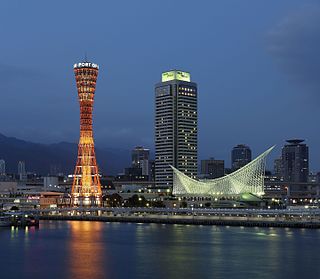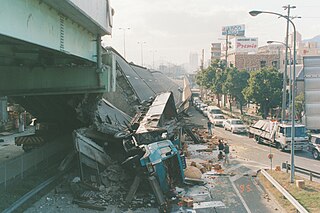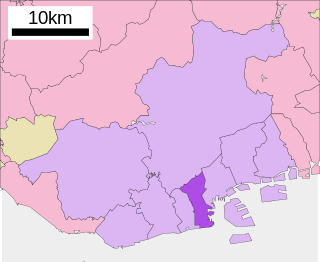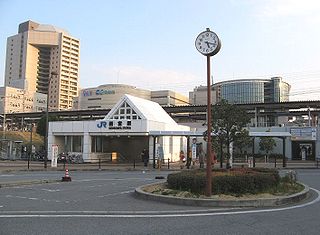
Kobe is the capital city of Hyōgo Prefecture Japan. With a population around 1.5 million, Kobe is Japan's seventh-largest city and the third-largest port city after Tokyo and Yokohama. It is located in Kansai region, which makes up the southern side of the main island of Honshū, on the north shore of Osaka Bay. It is part of the Keihanshin metropolitan area along with Osaka and Kyoto. The Kobe city centre is located about 35 km (22 mi) west of Osaka and 70 km (43 mi) southwest of Kyoto.

An earthquake occurred on January 17, 1995, at 05:46:53 JST in the southern part of Hyōgo Prefecture, Japan, including the region known as Hanshin. It measured 6.9 on the moment magnitude scale and had a maximum intensity of 7 on the JMA Seismic Intensity Scale. The tremors lasted for approximately 20 seconds. The focus of the earthquake was located 17 km beneath its epicenter, on the northern end of Awaji Island, 20 km away from the center of the city of Kobe.

Hyōgo Prefecture is a prefecture of Japan located in the Kansai region of Honshu. Hyōgo Prefecture has a population of 5,469,762 and has a geographic area of 8,400 square kilometres (3,200 sq mi). Hyōgo Prefecture borders Kyoto Prefecture to the east, Osaka Prefecture to the southeast, and Okayama Prefecture and Tottori Prefecture to the west.

Kobe-Sannomiya Station, or simply Sannomiya Station, is located in the heart of Kobe, Japan. This station is the main railway terminal of Kobe.

Amagasaki is an industrial city located in Hyōgo Prefecture, Japan. As of 30 November 2022, the city had an estimated population of 455,555 in 223812 households, and a population density of 9000 persons per km². The total area of the city is 50.72 km2 (19.58 sq mi).

Nishinomiya is a city located in Hyōgo Prefecture, Japan. As of 1 November 2022, the city had an estimated population of 484,368 in 218,948 households and a population density of 4800 persons per km². The total area of the city is 99.98 square kilometres (38.60 sq mi). Nishinomiya is an important commercial and shipping city in the Kansai region with the third largest population in Hyōgo Prefecture. Nishinomiya is best known as the home of Kōshien Stadium, where the Hanshin Tigers baseball team plays home games and where Japan's annual high school baseball championship is held.

Hyogo is one of nine wards of Kobe, Japan. It has an area of 14.56 km2 and a population of 106,322.

Ashiya is a city in Hyōgo Prefecture, Japan. As of 1 November 2022, the city had an estimated population of 95,485 in 45562 households and a population density of 5200 persons per km². The total area of the city is 53.44 square kilometres (20.63 sq mi).

Nishinomiya Station is a passenger railway station located in the city of Nishinomiya, Hyōgo Prefecture, Japan. It is operated by the West Japan Railway Company. As a part of the JR West Urban Network, the following cards are accepted: J-Thru Card, ICOCA, Suica, Pasmo, and PiTaPa.
Imazu Station is the name of two separate passenger railway stations located in the city of Nishinomiya, Hyōgo Prefecture, Japan. One is operated by the private transportation company Hanshin Electric Railway and web other by the private transportation company Hankyu Railway.The two stations are connected with a passage.
The following is a timeline of the history of the city of Kyoto, Kyoto Prefecture, Honshu island, Japan.
The following is a general historical timeline of the city of Los Angeles, California in the United States of America.
The following is a timeline of the history of the city of Osaka, Japan.
The following is a timeline of the history of the city of Yokohama, Japan.
The following is a timeline of the history of the city of Nagasaki, Japan.
The following is a timeline of the history of the city of Nagoya, Japan.
The following is a timeline of the history of Fukuoka City, Japan.
The following is a timeline of the history of Tokyo, Japan.

The Wadamisaki Battery is a coastal defense located in Hyōgo-ku, Kobe, Japan. It was built in 1864 by the Tokugawa shogunate in the Bakumatsu period, shortly before the end of the Shōgun's reign. One of many batteries built by the shogunate towards the end of its reign, the Wadamisaki Battery is the only one remaining from several that were built around Osaka Bay and is today listed in the Japanese government's register of historic sites.
The Kobe Route, signed as Route 3, is one of the routes of the Hanshin Expressway system serving the Keihanshin area in Kansai, Japan. It is an intercity route that travels in an east to west direction from Osaka to Kobe, with a total length of 39.4 kilometers (24.5 mi).










